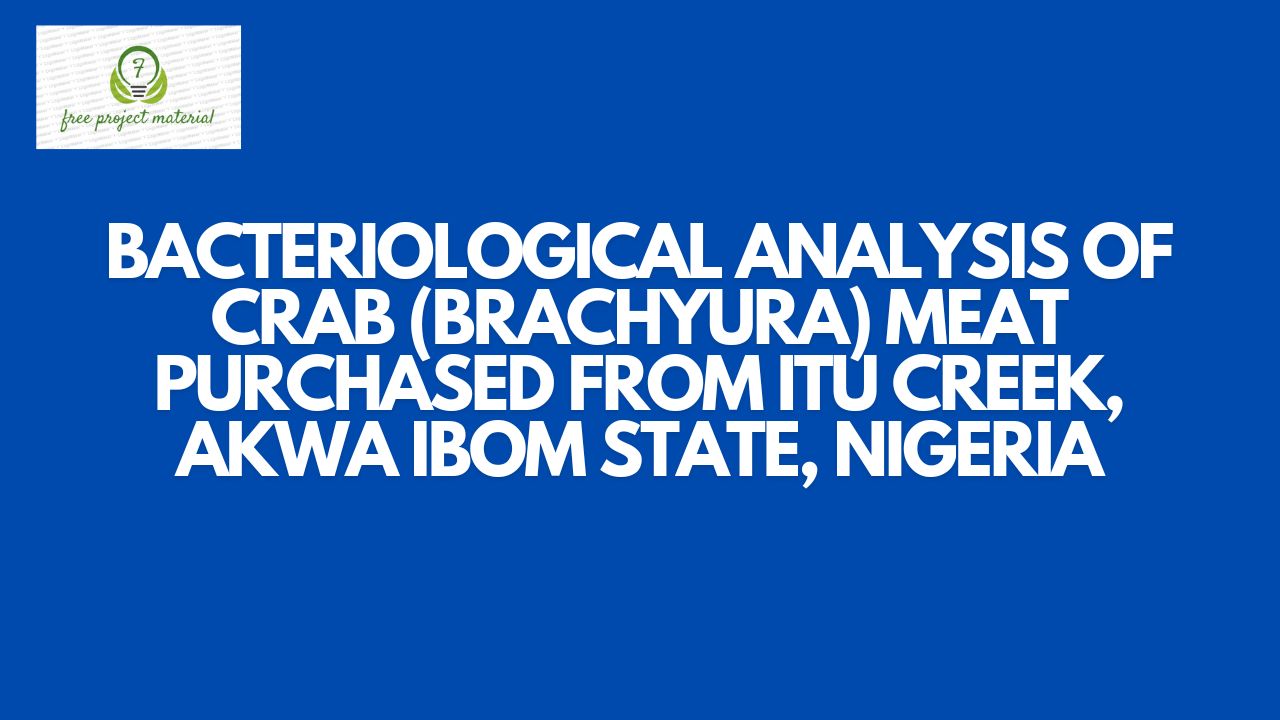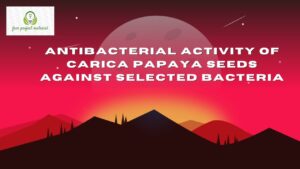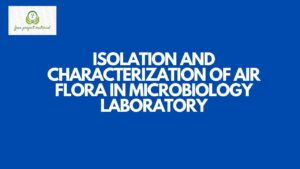ABSTRACT
The aim of this study was to carry out the bacteriological analysis of crab (Brachyura) purchased from Itu creek, Akwa Ibom State, Nigeria. A total of six (6) samples were purchased and taken to microbiology laboratory for analysis within 2 hours using standard procedures. The following isolates were obtained; Enterococcus sp, Bacillius sp, Staphylococcus sp and Escherichia coli. The mean total heterotrophic bacterial count of the crab samples show the highest bacterial count of (2.5 x 105cfu/g) from sample A1 while the least bacterial count was observed in sample A2 with (1.1 x 105cfu/g). The mean total coliform count of the crab samples showed the highest coliform count was (9.0 x 104cfu/g) from sample A1 while the least coliform count was observed in sample A2 with (8.0 x 104cfu/g). The highest percentage occurrence of the bacterial isolates was observed in Enterococcus sp with (40.8%) while the least was obtained in Staphylococcus sp with (24.5%). The only coliform isolated was Escherichia coli with 100%. The antimicrobial susceptibility pattern of bacterial isolates shows that Enterococcus sp was sensitive to erythromycin (25mm), ciproflox (22mm), ampiclox (19mm), streptomycin (18mm), and levofloxacin (18mm), and resistance to rifampicin (14mm), amoxil (10mm), chloramphenicol (9mm) and norfloxacin (7mm). Bacillus sp was sensitive to erythromycin (23mm), ampiclox (22mm), ciproflox (22mm), levofloxacin (21mm) and gentamycin (17mm), and resistance to norfloxacin (12mm), rifampicin (10mm), streptomycin (9mm) and chloramphenicol (7mm). Staphylococcus sp was sensitive to erythromycin (26mm), ciprofloxacin (23mm), amoxil (21mm), levofloxacin (20mm), ampiclox (20mm) and streptomycin (16mm), and resistance to rifampicin (12mm), norfloxacin (10mm) and chloramphenicol (10mm). Escherichia coli was sensitive to ciporoflox (22mm), reflacine (19mm), tarivid (18mm) and gentamycin (15mm) and resistance to ceporex (12mm), nalidixic acid (11mm), and amplicin (10mm).Since the bacterial count in these samples exceed the WHO permissible limit of 102-104 cfu/g, it therefore implies that the sample were not safe for consumption. In order to reduce the health risk of consumption and present the sample fit for consumption, it is recommended that the food sample should be thoroughly washed and boiled to kill the pathogens.
TABLE OF CONTENTS
Title Page – – – – – – – – – i
Certification – – – – – – – – ii
Dedication – – – – – – – – – iii
Acknowledgements – – – – – – – iv
Abstract – – – – – – – – – v-vi
Table of Contents – – – – – – – – vii-ix
CHAPTER ONE: INTRODUCTION
1.1 Background of the Study – – – – – – 1-4
1.2 Aim and Objectives of the Study – – – – 5
1.3 Scope and Limitation of the Study – – – – 5-6
CHAPTER TWO: LITERATURE REVIEW
2.1 Description of Crab – – – – – – 7-8
2.2 Classification of Crab – – – – – – 8
2.3 Nutritional Uses of Crab – – – – – – 9
2.4 Reproduction and Life Cycle – – – – – 10-12
2.5 Human Consumption of Crab – – – – – 13-15
2.5.1 Bacteria associated with contamination of crab meat – 15-24
2.6 Processing, Distribution and Preparation-related
Public Health Hazards – – – – – – 24
2.7 Proximate Composition – – – – – – 25-27
CHAPTER THREE: MATERIAL AND METHODS
3.1 Materials and Reagents – – – – – – 28
3.1.2 Sterilization of Materials – – – – – 28-29
3.2 Methods – – – – – – – – 29
3.2.1 Collection of Sample – – – – – – 29
3.2.2 Preparation of Sample – – – – – – 29-30
3.2.3 Characterization of Bacterial Isolate – – – – 30-31
3.3 Antimicrobial Susceptibility Test – – – – 31-32
CHAPTER FOUR: RESULTS AND DISCUSSION
4.1 Result – – – – – – – – 33-42
4.2 Discussion – – – – – – – – 43-47
CHAPTER FIVE: CONCLUSION AND RECOMMENDATION
5.1 Conclusion – – – – – – – – 48
5.2 Recommendations – – – – – – – 48-50
References
CHAPTER ONE
INTRODUCTION
1.1 Background of the Study
Crabs are decapod crustaceans of the infra order Brachyura, which typically have a very short projecting “tail” (abdomen) (Greek: brachys = short), usually hidden entirely under the thorax. They live in all the world’s oceans in fresh water and on land. They are generally covered with a thick exoskeleton and have a single pair of pincers. Many other animals with similar names such as hemit crabs, king crabs, porcelain crabs, horse shoe crabs, stone crabs and crab lice are not true crabs, but many have evolved features similar to true crabs through a process known as carcinisation.
The Itu river is an important economico through its fisheries and shell fish wealth. Unfortunately, the waters of this river and the immediate surrounding are under strong anthropogenic pressure including uncontrolled defection and dumping of waste water without treatment. These practices may significantly contribute to the pollution of river waters which can cause the bacteriological contamination of shell fish and fish. In most countries where the statistics exist, it shows that bacterial infectious diseases are the most communicable by fish and sea food (FAO, 1971). In New York, between 1980 and 1994, 339 outbreaks of food borne illness associated with fishery products have been reported with 3,959 patients, 76 hospitalizations and 4 deaths (Cohen and Karib, 2007). According to Olsen et al. (2000) in the United states, 25% of food borne diseases are related to fish consumption. WHO declared that between 1977 and 1984, many food-borne infections were due to consumption of crabs and shrimps (Bryan, 1988). These poisoning often caused by Salmonella sp., Escherichia coli., Staphylococcus aureus, Clostridium perfringens, Bacillus cereus can be quite severe. Baffone et al. (2000) reported that sea food is also involved in infections related to vibrio sp. in Cote d’ Ivoire. Bacteriological studies undertaken on seafood (fish, crabs, shrimps) fished in the Itu river revealed the presence of species of vibrionaceae (Dosso et al., 1983; Dosso et al., 1986; Traore et al., 2011). According to China et al. (2003) the main microbiological indicators consist of bacteria of the general Escherichia, Salmonella and Clostridium, main pathogens such as vibrio and Clostridium and secondary pathogens such as Camphylobacter, Staphylococcus and Areomonas etc. and viruses.
According to Chen et al. (2007), muscle meat contributes mainly for protein and amino acids, which accounts around 80% of the total whole body protein. Ke et al. (1990) reported that crab body meat contains 82.9% water, 16.0% protein, 0.86% fat, and 1.7% ash, and Krzynowek et al. (1982) reported that Jonah crab meat contains about 78% moisture, 16.2% protein, 1-2% fat, and 1.5% ash. The analysis of fatty acids has become increasingly important because more people have become aware of their nutritional and health implications. Lovern (1962) compared oils from special parts of fish and marine animals and found that large amounts of fatty acids are associated with phospholipids, glyceryl ethers, (alkoxydiglycerides) and wax esters, depending on the source of oils and lipids. Seafood lipids are rich in polyunsaturated fatty acids such as EPA and DHA. These fatty acids have a peculiarity of health benefits, including prevention of sudden cardiac death (Leaf et al., 2003) and chemopreventive effects of cancer (Akihisa et al., 2004). Linolenic acid (LNA, 18:3n-3), linoleic acid (LA 18:2n-6), eicosapentaenoic acid (EPA, 20:5n-3) and docosahexaenoic acid (DHA, 22:6n-3) were essential for the evaluation of nutritional quality of lipids (Gils, 2002). Omega 3 fatty acids can aid in reducing diseases of coronary artery (Skonberg and Perkins, 2002), inflammation (Harwood and Caterson, 2006; Gil, 2002; Shoda et al., 1996), coronary heart disease (Harper and Jacobson, 2005), cancer (Roynette et al., 2004), neurological disorders (Falinska et al., 2012), and can guarantee good health and normal development (Horrocks and Yeo, 1999; Innis, 2000; Voigt et al., 2000) and immune system (Sijben et al., 2009). Byrem and Strausburg (2000) mentioned about thin filaments consisting of four proteins; actins, tropomyosin, troponin and nebulin.
1.2 Aim and Objectives of the Study
Aim of the Study
The aim of the study was to evaluate the level of bacteriological contamination aspects of crabs (Callinectes amnicola) harvested from the Itu river.
Objectives of the Study
To isolate and identify the bacterial associated with contamination of crab meat.
Carry out antibiotic susceptibility profiles on the isolated bacteria
Determine the frequency and percentage occurrence of the isolated bacteria.
1.3 Scope and Limitation of the Study
This research is on bacteriological analysis of crab from Itu river, Akwa Ibom State only.
Limitation of the Study
This study is limited to the analysis of the bacteriological composition of crab within the catchment of Itu River, Akwa Ibom State and also financial constraint to have analyzed the virulence genes each of the isolates have.



